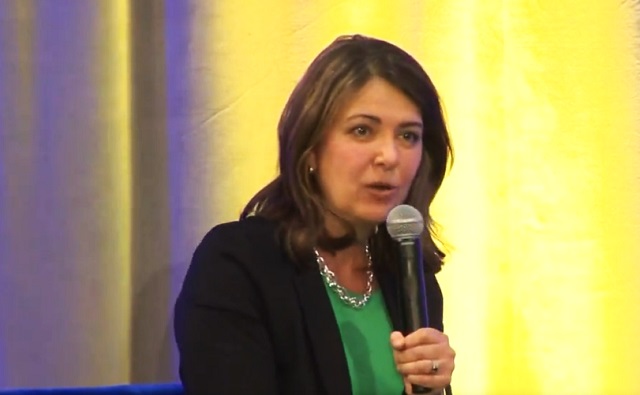Alberta
Alberta Premier tells environmental heckler a battery-powered electrical grid is pure ‘fantasy’

From LifeSiteNews
‘There is no industrialized economy in the world operating that way,’ Danielle Smith said at the 2023 Alberta Climate Summit
Alberta Premier Danielle Smith tore a page off a heckler’s fantasy suggestion of a solar and wind battery-powered future after she stepped into the lion’s den to advocate for oil and gas at a conference hosted by a pro-climate change think tank.
On October 26, Smith spoke at the Pembina Institute’s “2023 Alberta Climate Summit” in a “Fireside Chat, Premier Smith with Dave Kelly” to argue in favor of oil and gas and against proposals to phase out Alberta’s main energy industry.
While offering remarks in support of Alberta’s energy industry that includes fighting a federal government rule decreeing net-zero power emissions by 2035, Smith said trying to have the province go off natural gas for power generation by that year would be impossible after a heckler interrupted her.
Smith responded to the heckler by saying, “Do think I can get an equivalent amount of nuclear rolled out in 12 years? Do you think I could do that in an environment that we’ve never had nuclear before?”
“And what do I do when there’s no sun and there’s no wind?” she added.
At this point, the heckler shouted, “Batteries,” which irked Smith.
“Let’s talk about batteries, because I’ve talked to somebody and I want to I want to talk about batteries for a minute, because I know that everybody thinks that this economy is going to be operated on wind and solar and battery power and it cannot,” she said.
“There is no industrialized economy in the world operating that way because they need baseload. And I’ll tell you what I know about batteries because I talked to somebody who was thinking of investing in it on a 200-megawatt plant, $1 million to be able to get each megawatt stored. That’s $200 million for his plant alone. And he would get one hour of storage.”
Smith said that if one wants to have “12,000 megawatts of storage, that’s $12 billion for one hour of storage, $24 billion for two hours of storage, $36 billion for three hours of storage.”
The Pembina Institute lobbies for what it says is “reducing the harmful impacts of fossil fuels while supporting the transition to an energy system that is clean, safe and sustains a high quality of life.”
Companies such as Tesla offer both home as well as commercial battery pack applications that are designed to store electricity from wind, solar or the grid. However, such packs are massively costly and come with their own negative environmental footprints.
The institute’s goals align with those of the federal government under Prime Minister Justin Trudeau, who has imposed a punitive carbon tax on all Canadians.
‘Fantasy thinking’ won’t keep the lights on in winter, Smith says
Replying to the heckler, Smith stressed how in Alberta, which gets most of its power via natural gas and coal generators, with some solar and wind, there are “long stretches in winter where we can go weeks without wind or solar.”
“That is the reason why we need legitimate real solutions that rely on baseload power rather than fantasy thinking,” she said. “And I’m not going to engage in fantasy thinking and see something is possible when I know that my principal job, I think we need to stop.”
Smith said her “principal job is to have a reliable energy grid” and added that is what she is “trying to do.”
Former Liberal MP turned gas price analyst Dan McTeague, who is against the carbon tax and the push to ban gas-powered cars in favor of electric vehicles, said Smith’s remarks were “beautiful.”
“Beautiful,” McTeague wrote on X (formerly Twitter).
“Climate extremism performs poorly when confronted with reality.”
Trudeau’s carbon tax scheme falling apart
Cracks have begun to form recently. Faced with dismal polling numbers, Trudeau announced he was pausing the collection of the carbon tax on home heating oil in Atlantic Canadian provinces for three years.
This caused a immediate reaction from Saskatchewan Premier Scott Moe, who said his province will stop collecting a federal carbon tax on natural gas used to heat homes come January 1, 2024, unless it gets the similar tax break that Atlantic Canadian provinces.
The Trudeau government’s current environmental goals – in lockstep with the United Nations’ “2030 Agenda for Sustainable Development” – include phasing out coal-fired power plants, reducing fertilizer usage, and curbing natural gas use over the coming decades.
The reduction and eventual elimination of the use of so-called “fossil fuels” and a transition to unreliable “green” energy has also been pushed by the World Economic Forum (WEF) – the globalist group behind the socialist “Great Reset” agenda – an organization in which Trudeau and some of his cabinet are involved.
The Trudeau government has also defied a recent Supreme Court ruling and will push ahead with its net-zero emission regulations.
Canada’s Supreme Court recently ruled that the federal government’s “no more pipelines” legislation is mostly unconstitutional after a long legal battle with the province of Alberta, where the Conservative government opposes the radical climate change agenda.
Alberta has repeatedly promised to place the interests of their people above the Trudeau government’s “unconstitutional” demands while consistently reminding the federal government that their infrastructures and economies depend upon oil, gas, and coal.
Alberta
Red Deer Justice Centre Grand Opening: Building access to justice for Albertans

The new Red Deer Justice Centre will help Albertans resolve their legal matters faster.
Albertans deserve to have access to a fair, accessible and transparent justice system. Modernizing Alberta’s courthouse infrastructure will help make sure Alberta’s justice system runs efficiently and meets the needs of the province’s growing population.
Alberta’s government has invested $191 million to build the new Red Deer Justice Centre, increasing the number of courtrooms from eight to 12, allowing more cases to be heard at one time.
“Modern, accessible courthouses and streamlined services not only strengthen our justice
system – they build safer, stronger communities across the province. Investing in the new Red Deer Justice Centre is vital to helping our justice system operate more efficiently, and will give people in Red Deer and across central Alberta better access to justice.”

Government of Alberta and Judiciary representatives with special guests at the Red Deer Justice Centre plaque unveiling event April 22, 2025.
On March 3, all court services in Red Deer began operating out of the new justice centre. The new justice centre has 12 courtrooms fully built and equipped with video-conference equipment to allow witnesses to attend remotely if they cannot travel, and vulnerable witnesses to testify from outside the courtroom.
The new justice centre also has spaces for people taking alternative approaches to the traditional courtroom trial process, with the three new suites for judicial dispute resolution services, a specific suite for other dispute resolution services, such as family mediation and civil mediation, and a new Indigenous courtroom with dedicated venting for smudging purposes.
“We are very excited about this new courthouse for central Alberta. Investing in the places where people seek justice shows respect for the rights of all Albertans. The Red Deer Justice Centre fills a significant infrastructure need for this rapidly growing part of the province. It is also an important symbol of the rule of law, meaning that none of us are above the law, and there is an independent judiciary to decide disputes. This is essential for a healthy functioning democracy.”
“Public safety and access to justice go hand in hand. With this investment in the new Red Deer Justice Centre, Alberta’s government is ensuring that communities are safer, legal matters are resolved more efficiently and all Albertans get the support they need.”
“This state-of-the-art facility will serve the people of Red Deer and surrounding communities for generations. Our team at Infrastructure is incredibly proud of the work done to plan, design and build this project. I want to thank everyone, at all levels, who helped make this project a reality.”
Budget 2025 is meeting the challenge faced by Alberta with continued investments in education and health, lower taxes for families and a focus on the economy.

Quick facts
- The new Red Deer Justice Centre is 312,000 sq ft (29,000 m2). (The old courthouse is 98,780 sq ft (9,177 m2)).
- The approved project funding for the Red Deer Justice Centre is about $191 million.
Alberta
CPP another example of Albertans’ outsized contribution to Canada

From the Fraser Institute
By Tegan Hill
Amid the economic uncertainty fuelled by Trump’s trade war, its perhaps more important than ever to understand Alberta’s crucial role in the federation and its outsized contribution to programs such as the Canada Pension Plan (CPP).
From 1981 to 2022, Albertan’s net contribution to the CPP—meaning the amount Albertans paid into the program over and above what retirees in Alberta received in CPP payments—was $53.6 billion. In 2022 (the latest year of available data), Albertans’ net contribution to the CPP was $3.0 billion.
During that same period (1981 to 2022), British Columbia was the only other province where residents paid more into the CPP than retirees received in benefits—and Alberta’s contribution was six times greater than B.C.’s contribution. Put differently, residents in seven out of the nine provinces that participate in the CPP (Quebec has its own plan) receive more back in benefits than they contribute to the program.
Albertans pay an outsized contribution to federal and national programs, including the CPP because of the province’s relatively high rates of employment, higher average incomes and younger population (i.e. more workers pay into the CPP and less retirees take from it).
Put simply, Albertan workers have been helping fund the retirement of Canadians from coast to coast for decades, and without Alberta, the CPP would look much different.
How different?
If Alberta withdrew from the CPP and established its own standalone provincial pension plan, Alberta workers would receive the same retirement benefits but at a lower cost (i.e. lower CPP contribution rate deducted from our paycheques) than other Canadians, while the contribution rate—essentially the CPP tax rate—to fund the program would likely need to increase for the rest of the country to maintain the same benefits.
And given current demographic projections, immigration patterns and Alberta’s long history of leading the provinces in economic growth, Albertan workers will likely continue to pay more into the CPP than Albertan retirees get back from it.
Therefore, considering Alberta’s crucial role in national programs, the next federal government—whoever that may be—should undo and prevent policies that negatively impact the province and Albertans ability to contribute to Canada. Think of Bill C-69 (which imposes complex, uncertain and onerous review requirements on major energy projects), Bill C-48 (which bans large oil tankers off B.C.’s northern coast and limits access to Asian markets), an arbitrary cap on oil and gas emissions, numerous other “net-zero” targets, and so on.
Canada faces serious economic challenges, including a trade war with the United States. In times like this, it’s important to remember Alberta’s crucial role in the federation and the outsized contributions of Alberta workers to the wellbeing of Canadians across the country.
-

 2025 Federal Election2 days ago
2025 Federal Election2 days agoStudy links B.C.’s drug policies to more overdoses, but researchers urge caution
-

 2025 Federal Election2 days ago
2025 Federal Election2 days agoConservatives promise to ban firing of Canadian federal workers based on COVID jab status
-

 International2 days ago
International2 days agoPope Francis Got Canadian History Wrong
-

 Business2 days ago
Business2 days agoIs Government Inflation Reporting Accurate?
-

 2025 Federal Election2 days ago
2025 Federal Election2 days agoCarney’s Hidden Climate Finance Agenda
-

 2025 Federal Election2 days ago
2025 Federal Election2 days agoWhen it comes to pipelines, Carney’s words flow both ways
-

 Environment2 days ago
Environment2 days agoExperiments to dim sunlight will soon be approved by UK government: report
-

 Censorship Industrial Complex2 days ago
Censorship Industrial Complex2 days agoIs free speech over in the UK? Government censorship reaches frightening new levels





